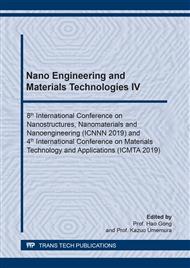[1]
S. Venkata Mohan, J. Karthikeyan, Removal of lignin and tannin colour from aqueous solution by adsorption onto activated charcoal. Environ. Pollut. 97 (1997), pp.183-187.
DOI: 10.1016/s0269-7491(97)00025-0
Google Scholar
[2]
Z. Qinglin, C. Karl T., Adsorption of organic pollutants from effluents of a Kraft pulp mill on activated carbon and polymer resin. Adv. Environ. Res. 3 (2001), pp.251-258.
DOI: 10.1016/s1093-0191(00)00059-9
Google Scholar
[3]
M. Dinesh, P. Charles U. Jr., and S. Philip H., Single, binary and multicomponent adsorption of copper and cadmium from aqueous solutions on Kraft lignin—A biosorbent. J. Colloid Interf. Sci. 297(2) (2006), pp.489-504.
DOI: 10.1016/j.jcis.2005.11.023
Google Scholar
[4]
J. Lora, Industrial commercial lignins: Sources, properties and applications. in Monomers, Polymers and Composites from Renewable Resources, edited by Belgacem, M., and Gandini, A. (eds.), Elsevier, Oxford, UK (2008), p.225 – 241.
DOI: 10.1016/b978-0-08-045316-3.00010-7
Google Scholar
[5]
R. Aravamuthan, W.Y. Chen, K. Zargarian, and G. C. April, Ethanol from southern hardwoods: the role of presulphonation in the acid hydrolysis process. Biotechnology and Bioengineering Symposium, John Wiley & Sons (1986), p.115 – 127.
DOI: 10.1080/00986448808940608
Google Scholar
[6]
R.J.A. Gosselink, E. de Jong, B. Guran, and A. Abächerli, Coordination network for lignin-standardisation. production and applications adapted to market requirements (EUROLIGNIN). Ind. Crops Prod. 20 (2004), pp.121-129.
DOI: 10.1016/j.indcrop.2004.04.015
Google Scholar
[7]
A.L. Macfarlane, R. Prestidge, M.M. Farid, and J.J.J. Chen, Dissolved air flotation: A novel approach to recovery of organosolv lignin. Chemical Engineering Journal 148(1) (2009), pp.15-19.
DOI: 10.1016/j.cej.2008.07.036
Google Scholar
[8]
B. Krzysztof, J. Krzysztof, KOH activated lignin-based nanostructured carbon exhibiting high hydrogen electrosorption. Carbon 46 (2008), p.1948 - (1956).
DOI: 10.1016/j.carbon.2008.08.005
Google Scholar
[9]
B. Krzysztof, J. Dawid, J. Krzysztof, Electrochemical hydrogen storage in activated carbons with different pore structures derived from certain lignocellulose materials. Carbon 50 (2012), pp.5017-5026.
DOI: 10.1016/j.carbon.2012.06.030
Google Scholar
[10]
T. Nagy L., H. Ming, I. Shinsuke, S. Hiroaki, B. Alexis A., I. Masataka, A. Katsuhiko, S. Yoshio, and Y. Yusuke, Direct synthesis of MOF-derived nanoporous carbon with magnetic Co nanoparticles toward efficient water treatment. Small 10 (2014), pp.2096-2107.
DOI: 10.1002/smll.201302910
Google Scholar
[11]
C. Binling, M. Guiping, K. Dali, Z. Yanqiu, and X. Yongde, Atomically homogeneous dispersed ZnO/N-doped nanoporous carbon composites with enhanced CO2 uptake capacities and high efficient organic pollutants removal from water. Carbon 95 (2015), pp.113-124.
DOI: 10.1016/j.carbon.2015.08.015
Google Scholar
[12]
P. Maryam, Q. Ali, R. Ramakrishnan, and F. Henry C., On the effects of confinement within a catalyst consisting of platinum embedded within nanoporous carbon for the hydrogenation of alkenes. Carbon 66 (2014), pp.459-466.
DOI: 10.1016/j.carbon.2013.09.022
Google Scholar
[13]
Suhas, P.J.M. Carrott, and M.M.L. Ribeiro Carrott, Lignin - from natural adsorbent to activated carbon: A review. Bioresource Technology 98 (2007), pp.2301-2312.
DOI: 10.1016/j.biortech.2006.08.008
Google Scholar
[14]
M. Ana and C. Ana P., Nanoporous Carbon Synthesis: An Old Story with Exciting New Chapters,, Porosity - Process, Technologies and Applications (2018), pp.37-68.
DOI: 10.5772/intechopen.72476
Google Scholar
[15]
A. Zeid A., A Review: Fundamental Aspects of Silicate Mesoporous Materials,, Materials 2012, 5, pp.2874-2902.
Google Scholar
[16]
A. Mays, H. D. Doan, and C. Chil-Hung, A Review on Breathing Behaviors of Metal-Organic-Frameworks (MOFs) for Gas Adsorption,, Materials 2014, 7, pp.3198-3250.
DOI: 10.3390/ma7043198
Google Scholar
[17]
I. Korbag, S.M. Saleh, Extraction of Lignin from Paper Industry Waste. International Journal of Applied Engineering Research 9(23) (2014), p.19421 – 19428.
Google Scholar
[18]
K.K. Pandey, A.J. Pitman, FTIR Studies of the Changes in Wood Chemistry Following Decay by Brown-rot and White-rot Fungi. International Biodeterioration & Biodegradation 52 (2003), pp.151-160.
DOI: 10.1016/s0964-8305(03)00052-0
Google Scholar


